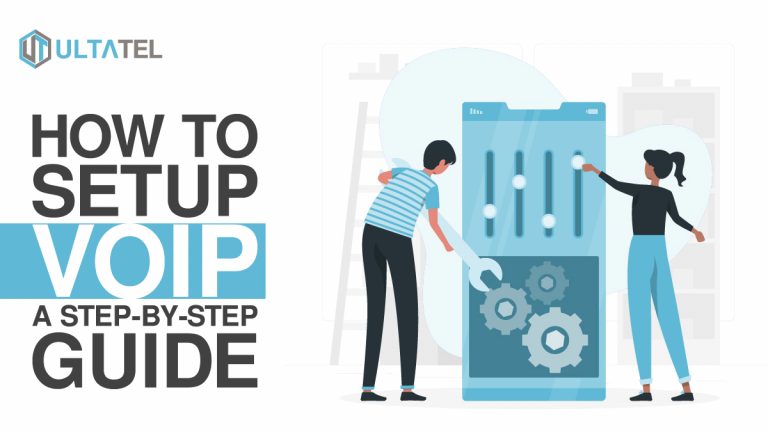As technology continues to advance, business owners of all niches are realizing the value of VoIP systems over traditional landlines. Thanks to VoIP’s cost efficiency and accessibility, running a system through your home office is more common than ever—but how do you set one up?
This guide will take you through the ins and outs of what you need to set up a VoIP system and how to configure one in your company building or home office.
What You Need to Setup a VoIP Phone System
While home VoIP systems and their small business counterparts differ in several ways, you’ll generally have to adhere to the same requirements. Below are a few things you’ll need to set up a VoIP system in both settings.
- Internet Connection: A reliable high-speed internet connection is crucial for a VoIP phone system. Consider a dedicated internet connection for voice traffic to ensure high call quality and minimal disruptions.
- VoIP Service Provider: You’ll need to choose a VoIP service provider that suits your needs. Providers like ULTATEL will handle the call routing, manage phone numbers, and provide the necessary infrastructure for your phone system.
- VoIP Phones: VoIP phones are compatible with internet-based phone systems. These phones use the Session Initiation Protocol (SIP) to establish and manage calls over the Internet. You can choose from desk phones, cordless phones, or softphones (software-based phones that run on computers or mobile devices).
- Network Equipment: Routers and network switches are necessary to connect your VoIP phones to the internet and create a local area network (LAN). Quality of Service (QoS) capabilities on your network equipment help prioritize voice traffic for better call quality.
- Firewall and Security: VoIP networks are occasionally prone to hacking, so implementing firewalls, intrusion detection systems, and other security measures can protect your VoIP system from potential threats.
- Bandwidth Assessment: Assess your bandwidth requirements to determine the Internet bandwidth required to handle simultaneous calls and maintain call quality. Your VoIP service provider can help you identify the ideal bandwidth.
- Network Configuration and Setup: Proper network configuration involves ensuring that the network infrastructure, including routers, switches, and firewalls, is correctly configured to handle VoIP traffic and prioritize it over other network traffic.
Below are a few optional add-ons to enhance your VoIP connection:
- VoIP Gateway: If you have existing analog phones, you may need a VoIP gateway to convert the analog signals to digital for compatibility with the VoIP system.
- Power over Ethernet (PoE) Switches: If you’re using IP-based VoIP phones, PoE switches can provide power to the phones through the Ethernet cables, eliminating the need for separate power adapters for each phone.
- PBX (Private Branch Exchange) System (Optional): You might consider implementing a PBX system for larger organizations or advanced call management features. A PBX allows for call routing, transferring, voicemail, auto attendants, and other advanced telephony features.
How to Setup a VoIP Phone System in Your Office
Office VoIP systems may require a more hands-on setup with a service provider. Whether incorporating physical lines or software-only setups, keep these preparation tips in mind.
Preparation
Before setting up a VoIP phone system in your office, you should plan and prepare to ensure a smooth installation.
Consider these steps:
- Assess your requirements: Determine the number of phone lines you need, the features and functionalities required (e.g., voicemail, call forwarding, auto-attendant), and any specific integration needs with existing systems (e.g., CRM software).
- Choose a VoIP service provider: Research and select a reliable VoIP service provider that aligns with your business needs. Consider factors such as call quality, pricing plans, customer support, and the availability of essential features.
- Evaluate your network: Assess your current infrastructure, including internet connection speed and capacity, to ensure it can support VoIP traffic. Consider implementing Quality of Service (QoS) settings to prioritize voice traffic and ensure call quality.
Hardware Setup
After the preparation stage, it’s time to set up the hardware components of your VoIP phone system.
Follow these steps:
- Acquire VoIP phones: Purchase VoIP phones based on your requirements and budget. Choose from desk phones, cordless phones, or software-based phones (softphones) that run on computers or mobile devices. Ensure the phones are compatible with your chosen VoIP service provider.
- Connect VoIP phones: Connect your VoIP phones to your network using Ethernet cables. If you’re using Power over Ethernet (PoE) phones, connect them to PoE switches that provide power and network connectivity through a single line. Otherwise, use power adapters to supply power to the phones.
- Configure network equipment: Configure your router, switches, and firewalls to support VoIP traffic. Set up port forwarding if necessary, and enable QoS settings to prioritize voice traffic over other data on your network.
Software Setup
With the hardware in place, it’s time to configure the software components of your VoIP phone system.
Note these steps:
- Set up VoIP accounts: Contact your VoIP service provider to obtain your usernames, passwords, and server details. Use this information to configure your VoIP phones or softphone applications.
- Configure phone system features: Log in to your VoIP service provider’s web portal or administration interface to configure various phone system features like voicemail, call forwarding, auto-attendants, and other functionalities.
- Test and troubleshoot: Conduct thorough testing of your VoIP phone system to ensure everything functions correctly. Make internal and external test calls for call quality. If you encounter any issues, check network settings and phone configurations, and contact your VoIP service provider for assistance.
- Train employees: Provide training and guidance to teams regarding how to use the new VoIP phone system. Familiarize them with basic phone operations, voicemail setup, call transferring, and any other features relevant to their roles.
How to Setup a VoIP Phone System at Home
Home VoIP systems are often less complex to prepare than office structures and most users have no problem setting up without much guidance. Here’s a quick rundown of the preparation process.
Preparation
Accessing your VoIP system’s feature-rich communication capabilities requires careful preparation—but your home requirements may differ. Before you begin the setup process, make sure to follow these preparatory steps:
- Consider what you need: Determine your communication needs. Since you’re at home, will you need multiple phone lines? What features (e.g., call waiting, voicemail) will most benefit your home office? Do you already have systems that require integration with other devices? The answers to these questions will provide a compass for your setup.
- Select a VoIP provider: Research and select a reputable VoIP service provider that offers residential plans.
- Review your Internet connection: Ensure you have a stable and reliable high-speed internet connection. Home Internet plans may not be as robust as their office-based counterparts.
Hardware Setup
Once you’ve determined your needs, it’s time to set up the hardware components of your VoIP phone system at home. Follow these steps:
- Pick your devices: Depending on your home office preference, choose from a variety of VoIP phone options (dedicated VoIP phones, cordless VoIP phones, or mobile applications).
- Connect your phone: Connect your VoIP phones to your home network. If you’re using a dedicated VoIP phone, connect it directly to your router or modem using an Ethernet cable. For cordless VoIP phones, follow the manufacturer’s instructions to connect the base station to your network. If you prefer softphone applications, download and install the appropriate software on your computer or mobile device.
- Power your VoIP system appropriately: If your phone requires a separate power adapter, connect it to a power source. However, if you have Power over Ethernet (PoE) capable phones, they can draw power from the Ethernet cable itself, provided your network equipment supports PoE.
Software Setup
With your hardware in place, it’s time to configure the software components of your VoIP phone system. Follow these steps:
- Open your VoIP account Like with an office setup, obtain the appropriate information from your service provider to configure your system.
- Configure your devices: Access the settings or administration interface of your VoIP phone or softphone application. Enter the appropriate account details and follow manufacturer instructions.
- Test your connection: Give your VoIP phone system a try, reviewing call quality and noting any potential issues. If you encounter a problem, refer to the manual provided or contact your service provider for additional help.
Summary
While VoIP systems appear to have dozens of moving components, you can easily and affordably set one up in your home or office. With a reliable service provider, strong Internet connection, and well-delegated setup, you’ll no longer have to deal with the headaches that come with expensive international calls and complex line rentals.

